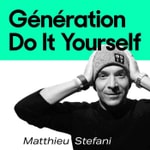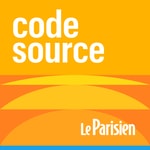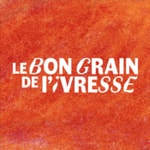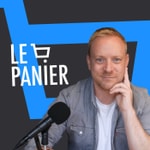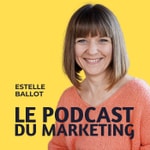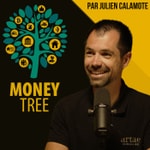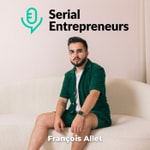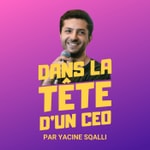Audio Branding – Details, episodes & analysis
Podcast details
Technical and general information from the podcast's RSS feed.
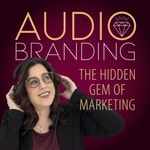
Audio Branding
Jodi Krangle
Frequency: 1 episode/7d. Total Eps: 296

Recent rankings
Latest chart positions across Apple Podcasts and Spotify rankings.
Apple Podcasts
🇺🇸 USA - design
12/07/2025#91🇩🇪 Germany - design
28/06/2025#82🇬🇧 Great Britain - design
18/06/2025#99🇬🇧 Great Britain - design
17/06/2025#86🇬🇧 Great Britain - design
16/06/2025#67🇬🇧 Great Britain - design
15/06/2025#55🇬🇧 Great Britain - design
14/06/2025#39🇩🇪 Germany - design
12/06/2025#82🇩🇪 Germany - design
02/04/2025#98🇺🇸 USA - design
30/03/2025#82
Spotify
No recent rankings available
Shared links between episodes and podcasts
Links found in episode descriptions and other podcasts that share them.
See all- https://op3.dev/privacy
1803 shares
- https://podcasthon.org/
225 shares
- https://www.garyvaynerchuk.com/
205 shares
- https://twitter.com/Jeanna_Isham
118 shares
- https://twitter.com/JodiKrangle
31 shares
- https://twitter.com/judyrodman
6 shares
RSS feed quality and score
Technical evaluation of the podcast's RSS feed quality and structure.
See allScore global : 89%
Publication history
Monthly episode publishing history over the past years.
In the Clubhouse: AI in Podcasting – Part 1
Season 1 · Episode 258
mercredi 23 octobre 2024 • Duration 37:19
“With AI coming along, I sort of look at more things being added into the workflow over the last year or so. A lot of it is, like, transcription, but also, ‘how are we gonna title the podcast?’ Show notes being written, I’m a little bit leery of, but it is used to assist in the process to write better show notes. So, I think for a long time, a lot of people have skipped over that, and AI has allowed us to write better show notes. That doesn’t mean copy-and-paste them in because AI is not... AI is, it’s an absolutely horrible writer. And I think one of the things that, I know this will come up in our discussion today, is that when you see AI stuff just being copied and pasted, you know that it has been copied and pasted.” – Matt Cundall
If there’s one topic that has captured the collective psyche over the past few years, it’s AI. But while the topic is fascinating, the uses are endless, and figuring out where it best fits into your work process is another matter entirely. The group I recently assembled on Clubhouse to talk about AI in Podcasting included a lot of veterans in the area of audio, video, and podcasting. They include voice actor and owner of The Sound Off Media Company, Matt Cundill; founder of Home Studio Mastery, Junaid Ahmed; on-air host and technical producer, mastering engineer, and podcast and audiobook post-production professional at AR Media, Sean Savage; founder of Spoken Life Media, LLC and Podcast Hall of Fame Inductee Rob Greenlee; and long-time audio technology consultant and co-host of the Pro Audio Suite Podcast, George Whittam. Each one of them had valuable insights into what tools work best for them and what tools you might want to look into for your own production.
Considering where the industry is heading, it’s probably a good idea to learn as much as you can about all these new and time-saving options. I hope you find this discussion super helpful!
As always, if you have questions for my panelists, you’re welcome to reach out through the links in the show notes. If you have questions for me, visit audiobrandingpodcast.com where you’ll find a lot of ways to get in touch. Plus, subscribing to the newsletter will let you know when the new podcasts are available and what the newest audio chats will be about. If you’re getting some value from listening, the best ways to show your support are to share this podcast with a friend and leave an honest review. Both those things really help – and I’d love to feature your review on future podcasts.
(0:00:00) - AI Tools in Podcast Creation
Our roundtable discussion starts as Matt introduces himself and discusses some of the strengths and weak spots of AI software, particularly when it comes to making corrections. “These tools,” he says, “have really helped, but I think if you rely on it too much, one of the things that we found out is that you can just waste as much time just by having to make corrections.” Rob joins in and shares his thoughts on the competition between cutting-edge AI startups and the major brands that are now catching up. “Some of the larger platforms,” he says, “are adding greater AI capability to them, and it’s putting a little bit in jeopardy some of the standalone AI kind of services or tools out there.”
(0:11:30) - AI Tools in Podcast Post-Production
Junaid introduces himself as well, and he tells us about some of the latest breakthroughs he’s seen in synthetic AI voices and the business boom for the voiceover artists behind them. “When they introduced the professional voice,” he says, “like, if you go in now, you can actually use some of the celebrity voices for your own stuff as well, and they’re getting paid...
How Sound and Music Influence Nature and Behavior: A Conversation with Pavle Marinkovic - Part 2
Season 1 · Episode 257
mercredi 16 octobre 2024 • Duration 30:11
“We typically think about music as a listening experience, playing an instrument, dancing. And I think that’s like a narrow view of seeing, of looking at this concept of music. And that was one of the inspirations. What I wanted to do in this book was to show that there’s another way of thinking about music that’s completely different from this, let’s say, three main ways we think about music. So if you step a little bit outside these traditional associations we have with what music is, you can find that, as we talked about, sound can affect plant development, it can influence the growth, the health of the plant. It can alter our sense of taste, enhance or diminish their own flavors. It can impact our moods. It can uplift us, calm us, energize us… and, well, audio branding uses that a lot, because emotions sell at the end of the day.” – Pavle Marinkovic
This episode is the second half of my conversation with writer and audio branding consultant Pavle Marinkovic as we discuss how music can influence our shopping habits, the latest research into sound’s effect on our cellular metabolism, and whether plants prefer Vedic chants or rock music.
As always, if you have questions for my guest, you’re welcome to reach out through the links in the show notes. If you have questions for me, visit audiobrandingpodcast.com where you’ll find a lot of ways to get in touch. Plus, subscribing to the newsletter will let you know when the new podcasts are available and what the newest audio chats will be about. If you’re getting some value from listening, the best ways to show your support are to share this podcast with a friend and leave an honest review. Both those things really help – and I’d love to feature your review on future podcasts.
(0:00:00) - The Influence of Music on Plants
As the second half of our discussion starts, Pavle tells us about sound’s effect on plants, including an experiment in India that found plants prefer Vedic chants and classical music over rock. “The plants grew taller,” he explains, “they had bigger flowers, and they had more flowers than the rock condition, and they also saw that the plants were growing towards the speaker.” He talks about the discovery that music can affect the growth of microorganisms such as E. Coli, and the dramatic difference that simply playing the right music made at a waste-treatment plant. “After a year of using this classical music,” Pavle says, “they were able to save ten thousand euros in the cost of transporting this sludge, so they reduced the amount of sludge produced by these sewage treatment plants.”
(0:16:30) - The Power of Sound and Music
We discuss the use of sound in shaping public behavior in recent years, from dispersing riots to chasing away loiterers, and how music can influence our behavior without us even realizing it. “For instance,” Pavle notes, “you can use the tempo of the music to make people either shop more, faster or slower, because they would unconsciously adapt to the sound cues that were at that moment happening.” He tells us why he believes sound is more important than we realize, and the growing research into music’s health benefits. “We think of music as a listening experience,” he observes, “playing an instrument, dancing, and I think that’s like a narrow view of looking at this concept of music.”
(0:24:24) - Exploring Music’s Impact Across Industries
Our conversation closes as Pavle tells us about his latest audio branding projects. “I’m always, always writing about music,” he says, “I’m also consulting on audio branding with people who have some, let’s say, problems with how to strategize about creating a...
Audio Dramas and Accessibility: A Conversation with Micah Thomas - Part 1
Season 1 · Episode 248
mercredi 14 août 2024 • Duration 25:17
“Early on in that we noticed that there are so many people in the blind and visually impaired community that are underrepresented in the respect of entertainment, both as an entertainer and as the consumer. The only products they have are descriptive videos on Netflix or something like that. And so they can’t get the exact same experience as the sighted world when they’re dealing with forms of entertainment. So we shifted our focus to the blind and visually impaired market, both as people who could assist us in making these audio dramas, our stories, more original, as well as sound-designing these things in a 360-degree or surround sound way so that those whose world is nothing but sound, they really could enjoy it in a way that was meant just for them.” -- Micah Thomas
This episode’s guest is a twenty-plus year content creator, armed with a Master’s Degree in Internet Marketing and a BA in Media Communications who’s found the right content to pour his energy into…sound. This father of six and husband of one has worked as a jack-of-all-trades in media but has become a master of audio and storytelling with his company Storymore. As a person with low vision, he has a passion for telling great stories in the best way he can, which led him to form a global group that’s disrupting the audio entertainment industry with its accomplishments. Chief among them is providing a platform that equalizes the playing field for those with visual disabilities.
His name is Micah Thomas, and our discussion covers a variety of topics, from audio dramas and music to how AI is changing both those industries. I think you’ll really enjoy his insights!
As always, if you have questions for my guest, you’re welcome to reach out through the links in the show notes. If you have questions for me, visit audiobrandingpodcast.com where you’ll find a lot of ways to get in touch. Plus, subscribing to the newsletter will let you know when the new podcasts are available and what the newest audio chats will be about. If you’re getting some value from listening, the best ways to show your support are to share this podcast with a friend and leave an honest review. Both those things really help – and I’d love to feature your review on future podcasts.
(0:00:00) – The Power of Audio Entertainment
We start things off with a trip down memory lane as Micah recalls the radio plays and adaptations that helped inspire his career in sound. “The stories captivated me,” he tells us, “because of the voice actors and how real they sounded, and I think that’s the first time via audio that it actually brought tears to my eyes.” We talk about how Storymore uses sound production to bring stories to life for blind and visually impaired listeners, and we listen to a clip from the Storymore original suspense tale Barley. “We had one guy that said the sound was so good,” he says, “that ‘I had to literally turn my head. I thought someone was entering the room because I heard a door open behind me.’”
(0:12:47) - AI Impact on Audio Entertainment
The conversation turns to AI and how it’s opening up new creative possibilities while leaving room for a human touch at Storymore, and Micah shares with us both the cover art and a sound clip of the Storymore original mystery Alibi. “There’s just no way,” Micah explains, “at this point in time, especially, that AI can reach the levels and depths of emotion and her mental state that she’s in to provide this type of performance.” We also discuss the difference between audible dramas and traditional audiobooks, and the storytelling power of sound. “It allows you the opportunity to point your own cameras,” he tells us,...
Scary Pigs and Phantom Planes: Audio Warfare Through the Ages
Season 1 · Episode 158
mercredi 23 novembre 2022 • Duration 05:51
During my last episode about sonic tactics, I talked about the different audio strategies that animals have developed for hunting prey and escaping predators, whether they're orcas using tail slaps to stun schools of fish or moths evading a bat's sonar with their clicks. As it turns out, some of those strategies are surprisingly similar to the sound tactics we've been using on the battlefield for centuries. This week I'll be delving deeper into how those same sonic strategies have played an important role throughout the history of war, from ancient Roman war pigs to inflatable army tanks.
Since animals already rely so much on sound to survive, it may be no surprise that one of the first uses of sound as a battle plan was to try and scare off the other side’s animals. Perhaps the most fearsome mount ever faced in antiquity was the war elephant: they were the tanks of the ancient world, massive and nearly unstoppable during a charge. But elephants are skittish, and it didn’t take long for their enemies to stumble upon a sound that would send even the bravest pachyderm running: the squeal of a pig. “War pigs,” as they came to be called, were sent stampeding among the approaching war elephants to make them panic and trample their own riders. To counter this gambit, elephant trainers began to raise pigs alongside their war elephants so they’d grow accustomed to the sound.
The idea of using sound to evoke fear among the enemy isn't limited to animals. One of the most distinctive sounds on the battlefields of ancient Japan is the kabura-ya (kah-burr-ah-yah) arrow, which literally translates as "turnip arrow." They're often called whistling arrows because, thanks to their hollow, turnip-shaped heads, that's just what they did. The sound of a kabura-ya flying through the air was believed to dispel evil influences, and they were used as signals to announce each army's arrival on a battlefield. While their use by samurai started to fade after the twelfth century, such arrows were also used by bandits to signal their approach all the way through the twentieth century.
Want to hear what one sounds like? There’s a video link on my blog so you can listen and imagine that ghostly whistle just before a battle, or while walking alone in a forest:
https://www.youtube.com/watch?v=maMnRvJVih8
While the sound of a kabura-ya arrow relayed honest, if unsettling, information about an approaching army or nearby bandits, wartime audio strategies often involved using sound to confuse the listeners. Just as some animals use sonic camouflage to disguise themselves, ancient armies learned to use sound to conceal their numbers and deceive their enemies. One of the oldest and most famous accounts of audio misdirection is the Biblical story of Gideon, who, around three thousand years ago, used horns, torches, and a scattered group of three hundred soldiers under the cover of darkness to trick an enemy camp into thinking they were under attack by a massive army and retreating.
That’s a strategy we’re still using today, even as we’ve replaced horns and torches with speakers and spotlights. During World War II, a top-secret group of American soldiers officially known as the 23rd Headquarters Special Troops arrived in Europe. They were nicknamed the “Ghost Army,” and their ranks included artists, architects, actors, and other creative professionals who could think on their feet. Their goal was to trick the German army into thinking their thousand-man unit was, in fact, an army of more than 30,000 soldiers, and draw their attention away from the Allies’ actual targets.
The Ghost Army did this by using inflatable prop tanks, trucks, and airplanes, by faking radio messages for the Germans to intercept, and through the use of sound in ways that never would've been possible before the twentieth century. They drove sound trucks equipped with massive amplifiers that could play and mix separate sound effect recordings to...
Tooth, Claw, and Clamor: How Animals Use the Power of Sound to Survive
Season 1 · Episode 157
mercredi 16 novembre 2022 • Duration 06:28
Five years ago, the first stories broke about a mysterious syndrome affecting American and Canadian diplomats in Cuba. Each case began with the victim hearing inexplicable grating sounds that people around them couldn’t detect, which then developed into headaches, hearing loss, vertigo, and even brain damage. New cases began to appear in embassies all around the world, with the most recent reports occurring just last year, and the phenomenon came to be known as Havana syndrome.
To this day, we still don't know what might be causing it. Theories range from secret government weapons to the power of mass suggestion, from exposure to harmful pesticides to the sounds of noisy tropical crickets. One of the earliest speculations was that it might be a sonic weapon, since we know that sound can be directed to a single listener without anyone else noticing, and that sound can do just as much harm as it can good. The secret behind Havana syndrome, whether it's an acoustic attack or something else, is still waiting to be uncovered, but sound's potential as a weapon is nothing new. Animals have been shaping soundscapes to their advantage for millions of years and we've used sound as a wartime strategy for just about as long as we've had wartime strategies.
This episode’s the first of a three-part series where I’ll be taking a look at how sonic tactics are used by everything from sperm whales to tiger moths, from Bronze Age battles to the now-famous “Ghost Army” of World War II, and just what the future of sonic warfare might hold.
We’re all familiar with the roar of a tiger, the howl of a wolf, or the hiss of a snake: animals use sound to not only communicate with each other but with their natural enemies, to warn them away and hopefully avoid a fight. But can animals use sound itself in a fight? The answer turns out to be yes, especially underwater where sound waves can be louder and more destructive than in the air. One such animal is the pistol or snapping shrimp, and I’ve talked about them before. Despite being barely an inch long, the pistol shrimp can create the loudest sound on Earth by snapping its claw to throw a literal bubble of sound at its prey, a bubble that’s as hot as the Sun and louder than a blue whale.
The title for the world's loudest animal arguably goes to the sperm whale, and it might also use sound as a weapon. Its clicks, which it uses for echolocation, are 230 decibels, so loud that they can be fatal to a diver who gets too close. Check out this link for a short video from author James Nestor about a diving team's awe-inspiring encounter with a pod of sperm whales, and how one diver found his left hand paralyzed for several hours after reaching too close to one of the clicking whales.
https://www.youtube.com/watch?v=zsDwFGz0Okg
Being around a sperm whale who's blasting away at full volume can be deadly for humans, but are their sounds also a weapon that they can aim and fire to stun giant squid? Biologists still aren't sure. For a long time, the answer seemed to be yes, but some more recent studies suggest that might not be the case: perhaps sperm whales are just loud because they're so big. Regardless, as one of the biggest and loudest animals to have ever lived, keeping our distance is probably a good idea.
Another cetacean (seh-tay-shan) that definitely uses sound to attack its prey is the killer whale, which hunts just about everything it can eat, from sharks to seals to other whales. When it comes to feeding on large schools of fish, a pod of orcas will often surround them and use slaps of their flukes, and the shock wave the sound makes, to stun the fish and keep them from swimming away. While the fish are left reeling from the blasts, the whales are free to eat as many as they like.
Here's a link to a rare underwater recording of such a feeding event, called “carousel feeding,” so you can see – and hear – their tail slaps for...
The Magic Moment: A Conversation with Joe Pardavila - Part 2
Season 1 · Episode 156
mercredi 9 novembre 2022 • Duration 32:26
“Do you know what I think makes a compelling podcast? It’s a podcast that doesn’t sound like a podcast. And I know that’s a really goofy answer, but if it sounds like two people talking or three people talking and they’re having this conversation, that there’s a genuine back and forth of information, that’s what makes the best podcast.” -- Joe Pardavila
This episode’s the second half of my interview with radio personality, producer, podcaster, and author Joe Pardavila, as we talk about unexpected interview answers, how improv training helped him learn how to live in the moment, and what makes a compelling podcast in his experience.
As always, if you have any questions for my guest, you’re welcome to reach out through the links in the show notes. If you have questions for me, just visit www.audiobrandingpodcast.com where you’ll find all sorts of ways to get in touch. Plus, subscribing to the newsletter (on the www.audiobrandingpodcast.com webpage) will let you know when the new podcasts are available.
A Polarized World
As the second half of the interview starts, we continue our talk about some of the most surprising interview answers Joe's received, including an offhand but revealing inside look at Chris Martin's family life. The key, he says, is to care about what people have to say, and to give them an opportunity to share their stories. “A lot of people like to hear themselves talk,” he explains, “but they need the opportunity.” And, he humorously adds, “that's why I'm here Jodi, just to hear myself talk. Just that.” We also discuss how polarized the world’s become these days and how much extra effort it can sometimes take to empathize with each other’s perspectives. “We can at least try to get to know each other better,” Joe tells us, “and that just means putting ourselves in the other person's shoes.”
Getting Out of Your Head
Joe goes on to tell us how he ended up learning improv from the Upright Citizens Brigade and joining a sketch comedy group, and the most valuable skill he learned from those experiences. “I was always on,” he recalls, “and just needed something to turn off, because the one thing you learn from improv is it's important to live in the moment and get out of your head.” We discuss how modern technology and social networks have made concentrating on the moment more of a challenge than ever, and the discipline it can take to keep ourselves focused and resist the urge to try and multitask. “It's so easy to be distracted,” he adds, “that we have to be really focused on not being distracted.”
Make Sure You’re Proud
When asked about the most common issues facing podcasters, Joe has a ready answer: editing and overlooking the sound quality. “Someone's dog starts barking like crazy,” he answers, “and they just keep going with the podcast... you can press pause, stop, let things pass, and then continue.” We talk about the limitations of Zoom when it comes to podcasting, ways to work around a limited audio budget, and his latest work on everything from recording audiobooks to interviewing CEOs and business leaders. As the episode comes to a close, he reflects on the staying power of podcasting, something that's often easily overlooked “The great thing about podcasts,” Joe says, “you put your podcast out there, it's going to be out there for eternity. So make sure you're proud of it.”
Episode Summary
- Joe’s most surprising interview answers and how to plan for a conversation
- How learning improv and comedy helped teach Joe to focus on the present
- Why the best podcasts are the ones that don’t sound like...
The Magic Moment: A Conversation with Joe Pardavila - Part 1
Season 1 · Episode 155
mercredi 2 novembre 2022 • Duration 36:33
“You have to create this environment that the person’s comfortable in, that’s a big part of it. And I don’t actually like to use the word interview, especially when I coach people or advise people who are starting podcasts. You don't ever want to use the word ‘interview’ because interview implies question answer, question answer, question answer, whereas a conversation is a back and forth, it’s people sharing ideas.”-- Joe Pardavila
My next guest has produced over ten thousand hours of audio content over the course of his career in podcasting and terrestrial radio. He was a radio personality and producer on the legendary New York City radio station, 95.5 PLJ, where he was part of the iconic Scott & Todd in the Morning. He studied Sketch & Improv Comedy at the Upright Citizens Brigade and was a founding member and actor in the New York-based sketch comedy group Clip Show. The group performed at the Upright Citizens Brigade Theater and the People’s Improv Theater, and their video sketches have been featured on Funny or Die and the Huffington Post. He’s also the co-director, writer, and producer of the award-winning horror satire The Witches of Bushwick and currently serves as the director of podcasts for Advantage Media Group/ForbesBooks.
His name is Joe Pardavila and, as you can probably tell, he’s spent much of his life understanding good audio and good conversation. His book Good Listen talks about the secrets behind creating compelling conversations and powerful podcasts. Sounds like he’ll fit right in here, so let’s get to it!
As always, if you have any questions for my guest, you’re welcome to reach out through the links in the show notes. If you have questions for me, just visit www.audiobrandingpodcast.com where you’ll find all sorts of ways to get in touch. Plus, subscribing to the newsletter (on the www.audiobrandingpodcast.com webpage) will let you know when the new podcasts are available.
In Love with Radio
As the interview starts, we talk about Joe's early memories of sound and how he used to stay up late at night as a child to secretly listen to sports news on the radio, "I would be in my bedroom underneath my blankets," he recalls, "listening to my little radio till 3 o'clock in the morning to see what the Mets had done." That radio under the blankets, he says, was a lifeline in the days before the internet and news on demand, and it changed the way he thought about sound, media, and particularly the power of radio. "That was sort of my connection," Joe says, "to the way I fell in love with radio."
Opening Up the World
Joe goes on to tell us how he came to work for WPLJ and Scott & Todd in the Morning, as a college internship turned into a surprise job offer. "I didn't have to think twice about it," he says. "I was like 'sure, who needs school?' And then that sort of opened my world up." He quickly progressed in his newfound career and, as he explains, "I ended up running the morning show by the time the morning show was blowing up in 2019." We talk about his mentors and how they influenced his career, and how a mentor can sometimes be just as valuable for the mistakes they teach you to avoid as the advice they offer. "One thing people don't realize about mentors and mentorship," he notes, "is it's not only the good things you can learn from your mentors. It's also the bad things."
Good Listening
Next, we talk about his foray into podcasting and writing his first book. "I was like 'I want to do podcasting,'" Joe reflects, "'but I don't want to do the same thing I'm doing on the air.'" His first podcast ended up being a...
Podcasting Goes Private: An Interview with Nora Sudduth - Part 2
Season 1 · Episode 154
mercredi 26 octobre 2022 • Duration 27:36
“When you hear that person on the other end, you can put yourself, as a prospective client, you put yourself in their shoes. You hear what their thought process was and you feel connected to that person, you understand exactly what their struggles are because I have the same concerns, I have the same hesitations, and that's very impactful.”-- Nora Sudduth
This episode continues my interview with marketing and conversion strategist and Hello Audio co-founder Nora Sudduth as we talk about sound-based lead magnets, strategies for facilitating and encouraging testimonials, and the future of social audio in a post-Clubhouse world.
As always, if you have any questions for my guest, you’re welcome to reach out through the links in the show notes. If you have questions for me, just visit www.audiobrandingpodcast.com where you’ll find all sorts of ways to get in touch. Plus, subscribing to the newsletter (on the www.audiobrandingpodcast.com webpage) will let you know when the new podcasts are available.
Making It Easier
As the second half of our interview starts, we discuss the three types of lead magnets that Nora has found work well, and how private podcasting fits into each one. "You're positioning yourself as an amazing guide to help them through that workbook,” she says of one strategy, combining workbooks and private audio feeds. “So the workbook in and of itself could still be valuable, but now you're taking things to the next level as their companion.” She tells us about Hello Audio’s most popular private podcast, a collection of success stories from clients, and how private podcasting has doubled some of their conversation rates. “They didn't change anything,” Nora says, “other than adding this private podcast to make it easier for people… it's a game changer when people actually consume that content."
A Desire for Connection
We also talk about the uncertain future of Clubhouse, and what it might mean for the growth of social audio as a trend. “That connection,” Nora assures us, “and that desire for connection, and to be able to listen to others and learn and be able to get to know them, that's not going to go away anytime soon.” She also reflects on the barriers new content creators can face and how social audio’s created more room at the table. “A lot of times,” she says, “starting as a video digital creator can be very difficult. It can create a lot of anxiety and it can prevent folks from getting themselves out there.”
What’s Old is New Again
Our interview wraps up with a lighthearted look at social audio's pre-internet past, at the days of teleseminars hosted over old-fashioned party lines. “I think what is old is new again,” Nora remarks, “and we're only going to see it expand.” We talk about some of the new features that are being developed by Hello Audio, and how they’re helping companies tap into the marketing opportunities that social audio and private audio feeds now offer. “If companies don't make the shift,” she adds, “or create opportunities to connect with their audience through audio, I think they're going to struggle.”
Episode Summary
- Three strategies for combining private podcasting and lead magnets
- The future of Clubhouse and the continued growth of social audio
- The pre-internet roots of social audio and its perennial value
- Hello Audio’s upcoming features and the future of private podcasts
Connect with the Guest:
Website: helloaudio.fm
Connect with Nora Sudduth on...
Podcasting Goes Private: An Interview with Nora Sudduth - Part 1
Season 1 · Episode 153
mercredi 19 octobre 2022 • Duration 30:35
“There are so many benefits to using audio that will ultimately help people consume the content you want them to consume. You're spending all this time creating it, you're putting all this love and energy into creating it – why not put it in a format that makes it easy for them to consume?” -- Nora Sudduth
This episode's guest is the co-founder of Hello Audio and is a leading marketing and conversion strategist who's helped businesses sell over $500 million worth of products and services online, and she’s designed several courses, coaching, and certification programs that have generated millions more. Her name is Nora Sudduth, and if you’re looking for ways to use audio for your business – especially when it comes to private podcasts, a concept that was new to me — this is the episode for you.
As always, if you have any questions for my guest, you’re welcome to reach out through the links in the show notes. If you have questions for me, just visit www.audiobrandingpodcast.com where you’ll find all sorts of ways to get in touch. Plus, subscribing to the newsletter (on the www.audiobrandingpodcast.com webpage) will let you know when the new podcasts are available.
An Accidental Podcaster
We start with a look at Nora's early memories of sound, at the importance of family in her life, and how her dad's favorite songs helped her see him in a whole new light. “From that age on,” she reflects, “music and, just, sound, it changed everything.” The conversation turns to how her marketing work led to a focus on the advantages of audio. “For me,” Nora says, “audio was about mobility and convenience and accessibility, and being able to incorporate that into an otherwise very busy lifestyle.” As she puts it, “I'm an accidental podcaster, I guess is kind of how I thought of it.”
Love and Energy
“Private podcasts enable you to be more relevant with the content you’re dropping per listener,” Nora tells us, “which is something public podcasts can’t do.” She explains the difference between traditional podcasting and private podcasts, the unique ways in which our brains and even the rest of our bodies respond to sound, and the advantages of being able to reach out to clients on a more individually tailored level. “You’re spending all this time creating it,” she says, “you’re putting all this love and energy into creating it, why not put it in a format that makes it easy for them to consume?”
Reaching Your Audience
Next, we talk about how private podcasts are transforming the employment sector and reshaping everything from employee handbooks to onboarding materials. "People are putting that information into audio," she explains, "and it comes to life." We discuss how social media and modern mobility, especially after the pandemic, have created new marketing challenges and opportunities. “You have to reach your audience where they're at,” Nora says, “and they're on their phones, on their mobiles.”
A Pattern Interrupt
As we come to the end of the first half of our interview, Nora tells us about how private podcasts can dramatically boost engagement numbers and overturn the traditional PDF lead magnet. “It can be an amazing piece of content,” she says about those old-fashioned marketing documents, “but it actually removes folks from the sale cycle.” We discuss how personalized audio feeds can replace or enhance other marketing strategies, and how audio’s often-overlooked role in marketing can turn into an advantage for companies willing to invest in it. “It’s kind of a pattern interrupt,” she says. “How many people do you know that are offering...
A Ph.D. in Podcasting: An Interview with Todd Cochrane - Part 2
Season 1 · Episode 152
mercredi 12 octobre 2022 • Duration 30:19
“My goal from the very very beginning was some are going to make take their spouse or partner to dinner money some people are going to make car payment money some people may make house payment money and some people may make life-changing money if I can get podcasters to the point of making enough money that gives them enough incentive to say yes this is possible to go bigger and grow bigger and to have the resources to pay for an editor and some of those things so I think the average podcasters now challenge unless they're a niche show or they've gown a significant audience is how do I get that initial taste of some cash and, really, the answer's going to be programmatic." -- Todd Cochrane
This episode’s the second part of my interview with author, CEO, and pioneering podcaster Todd Cochrane as we discuss strategies for improving podcast sound, the keys to monetizing and building on a podcast brand, and the importance of audio branding when it comes to podcasting.
As always, if you have any questions for my guest, you’re welcome to reach out through the links in the show notes. If you have questions for me, just visit www.audiobrandingpodcast.com where you’ll find all sorts of ways to get in touch. Plus, subscribing to the newsletter (on the www.audiobrandingpodcast.com webpage) will let you know when the new podcasts are available.
A Compelling Story
As the second half of our interview starts, Todd gives us his first piece of advice for improving podcast quality: "If you’re going to invest in anything, invest in a decent mic.” We discuss microphone options for different budgets, some of the other kinds of studio equipment he recommends, and a less technical, but no less important, suggestion on starting a podcast. “Have a compelling story,” Todd says. “Don’t go chasing topics: have something that you’re excited to talk about.” As he puts it, “lots of people are chasing categories now, and if you’re not in tune with that category, why would you do that?”
The Goal of the Show
When it comes to building a podcast, Todd has one driving question: "What is the goal of the show? Is the goal to have fun? Is the goal to have lead generation, is it to monetize?" We talk about different strategies of monetization, and he shares an account of one podcaster whose very precise niche turned out to be a gold mine. “If you’re a neurosurgeon,” he explains, “and you reach a thousand of the top neurosurgeons every episode, you can probably charge about $20,000 for that.” For most of us, however, Todd says the key is to build a wider audience: “You have to have a big audience for big money. Some people will fight me on this, but fundamentally, for most shows, that’s true.”
Let Your Voice Be Heard
As the episode comes to a close, we discuss audio branding and how it intersects with the world of podcasting, such as an early opening theme that proved too much for his listeners. “I was bombarded,” he recalls. “People said ‘I stopped, I couldn’t listen any further, that intro was horrible.’ It lasted one episode.” As he puts it, “you really have to find, you know, those elements” that work best for your particular audience. We discuss some of his current projects, and Todd offers one last piece of advice: "The main thing I want people to do is to start a podcast. That's the key: let your voice be heard."
Episode Summary
- The best microphones and sound equipment for podcasting
- Finding your own distinctive voice as a podcaster
- Strategies for monetizing content and building a podcast brand
- The synergy between audio...
